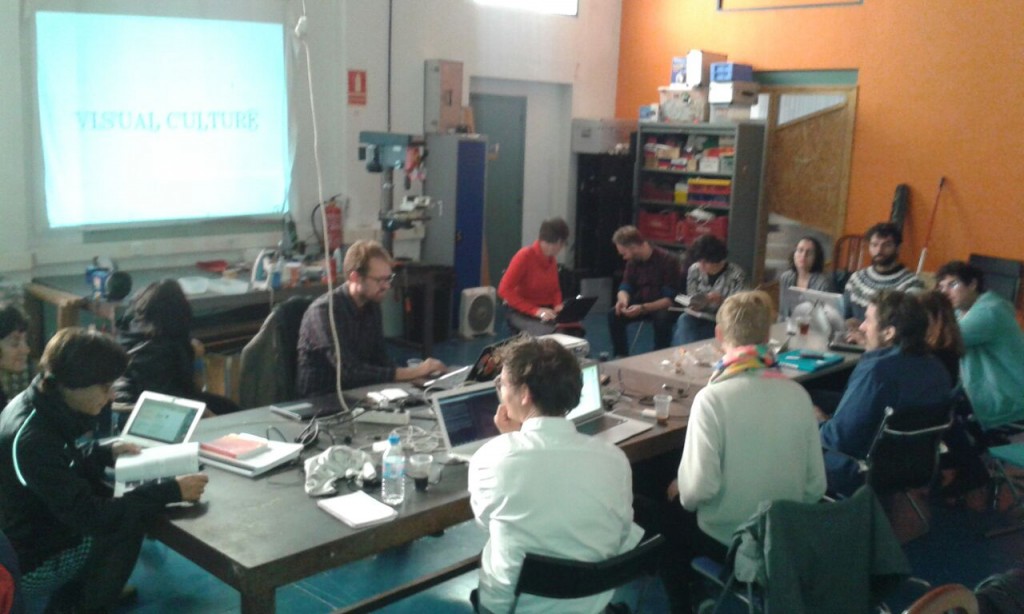The Methodology behind the Interface Manifesto
The PIPES_BCN methodology gradually took shape as the research project progressed. In general terms, we have used a multidisciplinary, qualitative and partially practice-based methodology.
The team members initially organised several meetings to define the object of study, which had to tie in with the objective of the Participatory Investigation in Public Engaging Spaces (PIPES) European program.
The overall goal of PIPES is to bring together artists, designers, communication theorists, and technologists to develop creative processes and new visual communication tools, produce online and offline artistic and educational events, and generate sustainable creative models for public participation. Specifically, PIPES seeks to create an interactive tool to generate new contexts for interaction and exchange, based on the language of symbols and icons.
The project is run by several European art and technology centres including ZKM in Karlsruhe and CIANT and BrainZ in Prague. In Barcelona, Hangar, in collaboration with the UOC, decided to embark on a critical overview that could generate a shared state of the art in the fields of interface design and data visualization.
As the project progressed, the emphasis on data visualization was gradually replaced by a focus on the ethical, aesthetic, philosophical, technical, semiotic, ideological, and social aspects of the interface. After discussing several texts, the main objectives of PIPES_BCN were defined as follows:
To produce an Interface Manifesto that that develops a critical approach to the interface. The idea is to generate a multidisciplinary conceptual framework from which to reflect on interfaces, rethinking their design and models of use while at the same time seeking to stimulate the creation of more open and collaborative interfaces.
Once the objective had been defined and participants had agreed that the Interface Manifesto would be the springboard, the engine of the research, and the ultimate goal, they drafted a theoretical framework that grew as the research progressed. This framework draws on disciplines such as science and technology studies, media studies, semiotics, software studies and actor network theory, to name just a few. The readings, compiled on the platform Zotero, generated a context for reflection which was gradually enriched as layers were added through a series of activities. Likewise, the research gradually generated a network of participating actors and institution, including BAU (Barcelona), Constant (Brussels), OST (Brussels), Xnet (Barcelona), and the CCCB (Barcelona), among others.
The activities carried out with a view to generating the diverse, open discourse around interfaces that was to end up leading to the production of the Interface Manifesto, were:
Keeping a record of the entire research process at pipes.hangar.org
Participating in Iconic Days, where part of the team introduced the European partners of the PIPES project to notions from the fields of semiotics and design theory.
Reading groups for the discussion of texts related to the objective of the research.
Hosting the Art Matters seminars on art and materiality at Hangar, including one that was specifically dedicated to interfaces. Organising an Interface Dictatorship Roundtable, with the participation of experts from new media, semiotics, design, politics and law, where progress was made in regard to understanding the complexity of the object of study of PIPES_BCN.
RAABLAB workshop, where Stella Veciana and Dan Norton used interaction strategies to help artists and scientists implement interconnected research practices. This workshop focused on research methodologies.
DIY Symbology: Make Your Own Symbols workshop with Genís Carreras, where participants reflected, through practice, on the subjectivity inherent to any design.
“Mixed experience: when “users” and “developers” make tools together” workshop with Femke Snelting and Open Source Publishing, where participants critically questioned how tools condition creative practice, and how users and developers can collaborate to improve software. As well as exploring the critical perspective, this workshop also looked at examples of open, participatory interfaces.
MEMBRANA Residency. An artist in residency programme was one of the key aspects of PIPES_BCN. Through an open call for participation, César Escudero was chosen to collaborate on the Interface Manifesto and to participate in the research through his artistic practice.
BOOKSPRINT
The research project will conclude with a Booksprint: a working method that consists of collaboratively producing a publication over an intensive booksprint weekend.
A series of preliminary meetings have been held to prepare for the Booksprint and the Interface Manifesto. The first sessions consisted of internal work, to define the main lines of interest. The people collaborating in the Interface Manifesto were invited to the following sessions, where these lines were discussed and honed. For this stage, the Open Source Etherpad platform proved to be very useful.
For the Booksprint, we expect collaborators to have contributed a text, and that the main points of the Interface Manifesto will have been agreed upon, so that we can concentrate on defining the form of the interface of the Manifesto.
The research project has also been presented at, or participated in, events such as the Free Culture Forum (Barcelona), Art Matters International Conference (Barcelona), the #edcd 15 Digital Culture and Design Conference at Medialab (Madrid), and Siglo XXI Radio Nacional 2 radio programme, which allowed participants to share ideas and methodologies with other artists, designers, and academics.

